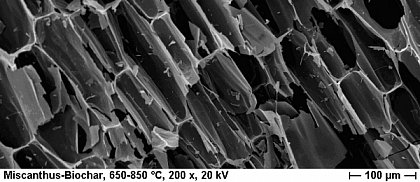Biochar
What is Biochar?

Miscanthus Biochar - microscope photography (Photo: Katja Wiedner)
Biochar is reduced carbon in a low oxygen atmosphere through a process called pyrolysis of biomass wastes. Biochar is important in two ways:
- It offers the only currently realisable way to remove CO2 from the atmosphere (CO2 sequestration).
- It can act as a soil conditioner, improving soils that have lost their fertility (Terra Preta).
Biochar and Climate Change
Humanity faces two issues with respect to climate change: reduce current and future GHG emissions and address the current high levels of CO2 in the atmosphere. At the moment, it has three tools with which to address current and future emissions:
- Renewables
- Energy efficiency
- Carbon capture and storage (CCS)
Biochar is the fourth tool and sits in its own category in that it is the ONLY currently available system able to safely sequester existing atmospheric CO2 as outlined above and as proven in numerous scientific publications.




